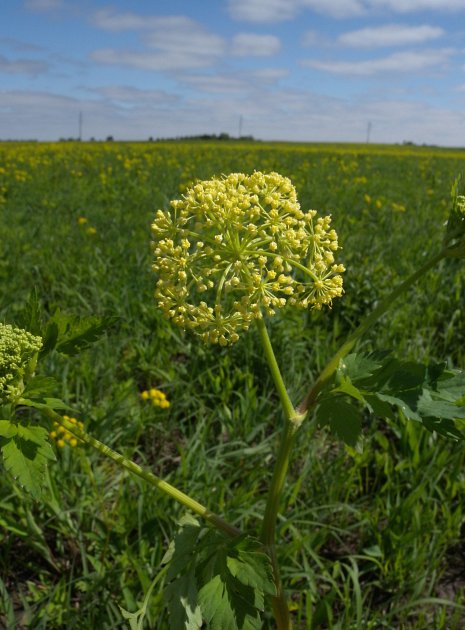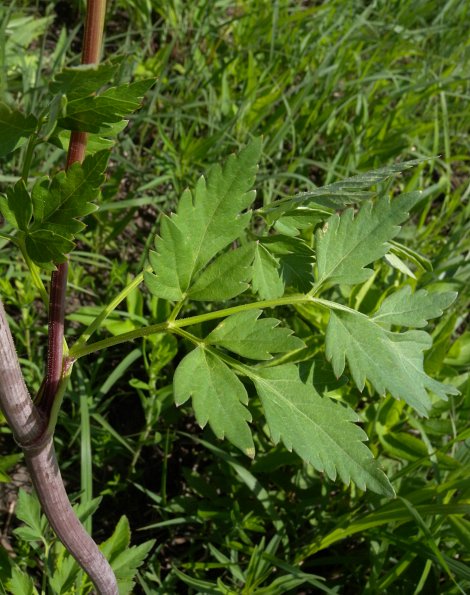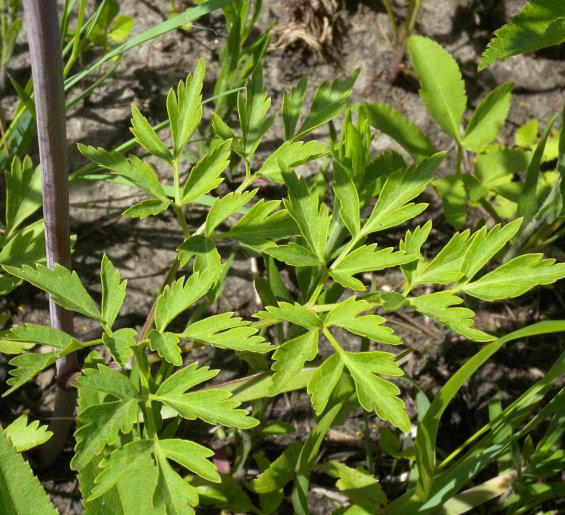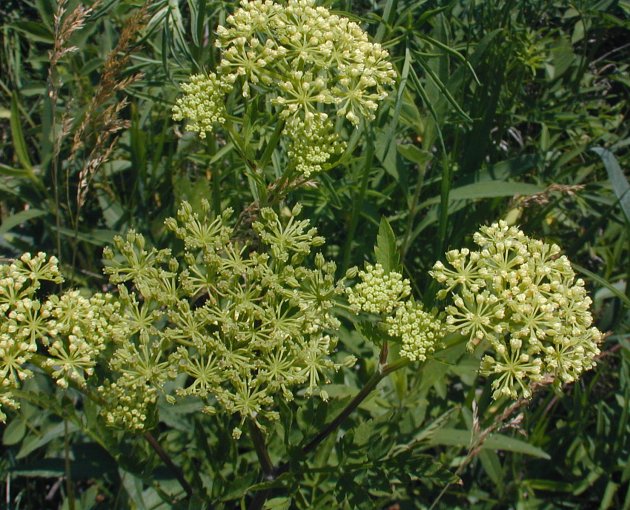Description: This is a perennial plant that branches sparingly, and it is up to 3½' tall. The central stem and lateral stems are relatively stout, terete, light green to reddish purple, and hairless. The alternate leaves are bipinnately or ternately compound, and they tend to be aggregated toward the base of the plant. The basal leaves are up to 12" long and 6" across, while smaller leaves are sparsely distributed along the middle and upper portions of the stems. There are usually minute stiff hairs at the base of the petioles where the compound leaves join the stem, otherwise the petioles and compound leaves are hairless.

The leaflets have medium to large blunt teeth and they are sometimes deeply cleft along their margins; the leaflets are often arranged in pairs or triplets within each compound leaf. Each leaflet is up to 1" long and ½" across with wedge-shaped lower margins. The overall appearance of the leaves resembles Italian Parsley. Rounded compound umbels of light yellow flowers occur at the ends of the central stem and major lateral stems. Each umbel is about 2-3" across, and it is composed of 12-20 umbellets. Each umbellet consists of a similar number of tiny flowers, each one with 5 petals. There is no noticeable floral scent. The blooming period occurs during the late spring or early summer, lasting about a month. The root system consists of a central taproot.

Cultivation:
The preference is full or partial sun and mesic conditions. The soil
can contain significant amounts of loam, sand, or rocky material. Light
shade is tolerated, but growth will be less robust and flowering less
abundant. Hairy-Jointed Meadow Parsnip develops rapidly during the
spring, and is usually taller than the surrounding plants when the
blooming period begins. After flowering, the condition of the plant
rapidly deterioratees.
Range &
Habitat:
This native plant occurs occasionally in scattered counties of
Illinois. Its
distribution is oddly bifurcated, consisting primarily of counties in
east-central and west-central Illinois (see Distribution
Map).
Habitats include mesic black soil prairies, openings in
forests and woodland borders, sandy savannas, rocky bluffs, and banks
of rivers and lakes. This plant occurs in prairies to a greater extent
than has been realized in the past.

Faunal Associations:
Many kinds of insects are attracted to the flowers, especially
short-tongued bees, wasps, flies, and beetles. The caterpillars of the
butterfly Papilio polyxenes asterias (Black
Swallowtail) feed on the foliage and flowers. This plant is not known
to be toxic, and it is probably consumed occasionally by various
mammalian
herbivores, although information about this is limited.
Photographic
Location:
The photographs of the flowering plant and compound leaf were taken at
Loda Cemetery Prairie in Iroquois County, Illinois. The photograph of
the umbels and upper leaves was taken at a woodland in Vermilion
County, Illinois.

Comments: This native member of the Carrot family should be grown more often in wildflower gardens. Sometimes it is called 'Hairy Meadow Parnsip,' but conspicuous hairs occur only at the base of the petioles of compound leaves, and these are not easy to see unless you know where to look. This plant resembles the weedy and aggressive Pastinaca sativa (Wild Parsnip), but the latter has flat compound umbels of yellow flowers, while Hairy-Jointed Meadow Parsnip has compound umbels of pale yellow flowers that are more rounded. There are also significant differences in the structure of the compound leaves between these two species.